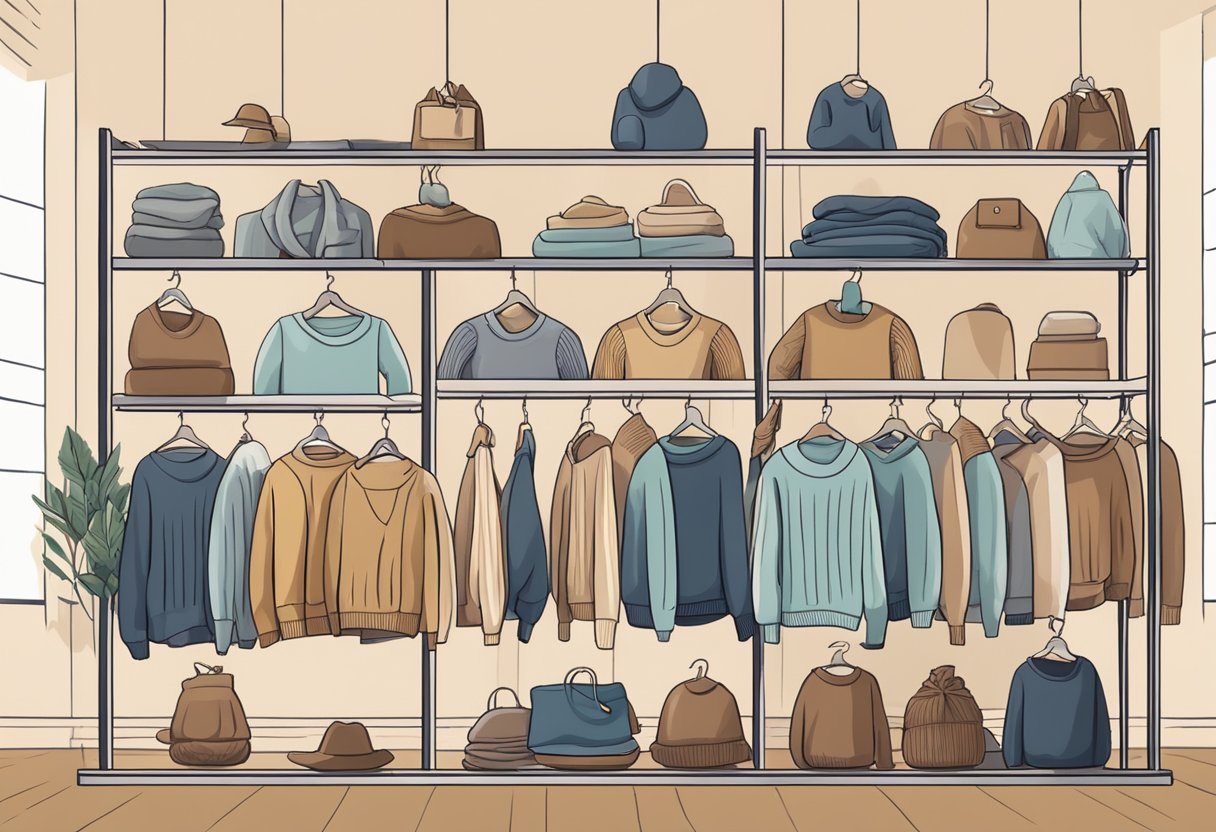Types Of Sweaters
Sweaters are a versatile and essential piece of clothing that can be worn in various settings and climates. From casual to formal wear, there is a sweater for every occasion. They come in different styles, materials, and designs, making it easy to find one that meets your needs.
When it comes to types of sweaters, there are many to choose from. Some popular styles include the crewneck, V-neck, turtleneck, cardigan, and hoodie. Each of these styles has its unique features and advantages, making it important to understand their differences to choose the right one for your needs.
In addition to style, sweater materials and fabrics play a crucial role in determining the comfort and durability of the garment. Some common materials used in making sweaters include wool, cotton, cashmere, and synthetic blends. Understanding the different materials and their properties can help you choose a sweater that fits well and feels comfortable.
Key Takeaways
- Sweaters come in different styles, materials, and designs, making it easy to find one that meets your needs.
- Popular styles include the crewneck, V-neck, turtleneck, cardigan, and hoodie.
- Understanding the different materials and their properties can help you choose a sweater that fits well and feels comfortable.
Types of Sweaters

When it comes to sweaters, there are a variety of styles to choose from. From classic knit designs to modern variations, there is a sweater for every occasion. In this section, we’ll explore some of the most popular types of sweaters and their unique features.
Cardigan Sweaters
Cardigan sweaters are a classic style that have been around for decades. They are characterized by their open front and button-up design, making them a versatile and easy-to-wear option. Cardigans can be dressed up or down, making them perfect for both casual and formal occasions.
Pullover Sweaters
Pullover sweaters are another popular style that come in a variety of designs. They are characterized by their lack of buttons or zippers, making them easy to slip on and off. Crew neck and v-neck pullovers are two of the most popular styles, with crew neck sweaters being a more casual option and v-neck sweaters being a bit dressier.
Specialty Sweaters
Specialty sweaters are designed for specific occasions and purposes. Ugly Christmas sweaters, for example, are a popular style during the holiday season. Aran and Fair Isle sweaters are two other specialty styles that are known for their intricate knit designs and traditional look.
Modern Variations
In recent years, there has been a surge of modern sweater variations. Cropped sweaters, oversized sweaters, and hoodie-style sweaters are just a few examples. These styles are often more casual and trendy, making them perfect for everyday wear.
Traditional Styles
For those who prefer a more classic look, traditional sweater styles are always in fashion. Cable knit and fisherman’s sweaters are two examples of traditional styles that have been around for decades. These sweaters are often made from high-quality materials and are built to last.
In conclusion, there are many types of sweaters to choose from, each with its own unique features and style. Whether you prefer a classic or modern look, there is a sweater out there for everyone.
Sweater Materials and Fabrics
When it comes to selecting a sweater, the material and fabric play a crucial role in determining its comfort, durability, and overall quality. Sweaters come in a variety of materials, including natural fibers, synthetic materials, and blends. Each material has its own unique properties and benefits, making them suitable for different occasions and weather conditions.
Natural Fibers
Natural fibers are derived from plants or animals and are known for their softness, breathability, and durability. Some of the most popular natural fibers used in sweaters include wool, cashmere, silk, alpaca, and linen.
Wool is a versatile and durable fiber that is naturally insulating and moisture-wicking. It is available in a range of textures and weights, making it suitable for different types of sweaters. Cashmere, on the other hand, is a luxury fiber that is known for its softness and warmth. It is lightweight and breathable, making it ideal for layering in cooler weather.
Silk is a smooth and lustrous fiber that is often blended with other materials to add a luxurious feel to the sweater. Alpaca is a soft and lightweight fiber that is naturally hypoallergenic and moisture-wicking, making it ideal for people with sensitive skin. Linen is a lightweight and breathable fiber that is perfect for summer sweaters.
Synthetic Materials
Synthetic materials are man-made fibers that are designed to mimic the properties of natural fibers. Some of the most common synthetic materials used in sweaters include polyester and acrylic.
Polyester is a durable and lightweight fiber that is often blended with other materials to add strength and durability to the sweater. Acrylic is a soft and warm fiber that is often used in mass-produced sweaters due to its affordability and ease of care.
Blends and Innovations
Blends are a combination of natural and synthetic fibers that offer the best of both worlds. They provide the softness and breathability of natural fibers with the durability and affordability of synthetic materials. Some popular blends include wool and acrylic, cotton and polyester, and cashmere and silk.
Innovations in sweater materials include the use of recycled fibers, such as recycled polyester and recycled cotton. These materials are eco-friendly and sustainable, making them a great choice for people who are conscious about their environmental impact.
In conclusion, the material and fabric of a sweater play a crucial role in determining its comfort, durability, and overall quality. Natural fibers offer softness and breathability, while synthetic materials provide durability and affordability. Blends and innovations offer the best of both worlds, making them a great choice for people who want the benefits of multiple materials in one sweater.
Sweater Fit and Comfort
Understanding Sizes and Fits
When it comes to sweaters, fit is one of the most important factors for both comfort and style. It is essential to find the right size and fit to ensure that the sweater not only looks good but also feels comfortable to wear.
Sweaters come in various sizes, including small, medium, large, and extra-large. It is crucial to refer to the sizing chart provided by the manufacturer to find the right size. The sizing chart should include measurements for chest, waist, and hips.
In addition to sizes, different fits are available, including slim fit, regular fit, and relaxed fit. Slim fit sweaters are designed to fit snugly to the body, while regular fit sweaters are more relaxed. Relaxed fit sweaters are ideal for those who prefer a looser fit.
Features for Comfort
When it comes to comfort, there are several features to look for in a sweater. One of the most important features is the material. Sweaters made from natural fibers such as wool, cashmere, and cotton are breathable and comfortable to wear. Synthetic materials such as acrylic and polyester may not be as comfortable.
Another feature to consider is the style of the sweater. Ribbed sweaters are designed to stretch and conform to the body, providing a comfortable fit. Cowl neck, roll neck, and shawl collar sweaters provide extra warmth and comfort around the neck.
For those who prefer an oversized fit, oversized sweaters are a great option. They provide a relaxed, comfortable fit that is both stylish and flattering. However, it is essential to balance the oversized fit with the rest of the outfit to avoid looking frumpy.
In conclusion, when it comes to sweater fit and comfort, it is essential to find the right size and fit and look for features that provide comfort. Sweaters made from natural fibers, ribbed sweaters, and cowl neck, roll neck, and shawl collar sweaters are all great options for comfort.
Accessorizing and Layering
Layering Techniques
Layering is an excellent way to stay warm and add depth to an outfit. When it comes to layering with sweaters, there are a few techniques to keep in mind. The first is to layer with a t-shirt or button-up shirt underneath. This will add a pop of color and texture to the outfit, and can also help to keep you warm. For a more formal look, a collared shirt can be paired with a sweater and a tie.
Another layering technique is to pair a sweater with a blazer or jacket. This can add a touch of sophistication to the outfit, while also keeping you warm. For a more casual look, a sweater can be layered with a denim or leather jacket.
When layering with sweaters, it’s important to pay attention to the details. Zippers, buttons, and collars can all add interest to an outfit. For example, a sweater with a zipper can be partially unzipped to show off a shirt underneath. A sweater with buttons can be worn open or closed, depending on the desired look.
Accessorizing with Sweaters
Sweaters can be a fashion-forward addition to any wardrobe. When it comes to accessorizing with sweaters, there are a few things to keep in mind. The first is to choose accessories that complement the sweater. For example, a chunky knit sweater can be paired with a scarf and hat in a similar texture.
Another way to accessorize with sweaters is to add a statement piece of jewelry. A bold necklace or pair of earrings can add interest to an outfit, while also drawing attention to the sweater.
Finally, it’s important to choose the right sweater for the occasion. A more casual sweater can be paired with jeans and sneakers, while a dressier sweater can be worn with slacks and dress shoes. By paying attention to the details and accessorizing appropriately, anyone can create a stylish and layered look with sweaters.
Care and Maintenance
Taking care of your sweaters is essential if you want them to last for a long time. Proper maintenance will ensure that your sweaters remain in good condition and continue to look great. Here are some tips on how to care for your sweaters:
Washing
When it comes to washing your sweaters, it’s important to follow the care label instructions. Some sweaters can be machine washed, while others require handwashing. If you’re unsure, it’s always best to err on the side of caution and handwash your sweaters.
When handwashing your sweaters, use lukewarm water and a mild detergent or baby shampoo. Gently swish the sweater around in the water and let it soak for 10 minutes. Rinse the sweater thoroughly but gently, and avoid wringing or twisting it.
If you decide to machine wash your sweaters, use the gentlest setting and skip the spin cycle. Use a dye-free detergent that rinses clean, and avoid using fabric softeners.
Drying
When it comes to drying your sweaters, it’s best to lay them flat on a towel or drying rack. Avoid hanging them up, as this can cause the sweater to stretch out of shape.
If you need to remove excess water from your sweater, gently press it between two towels. Never wring or twist the sweater, as this can damage the fibers.
Storage
When storing your sweaters, it’s important to fold them properly and avoid hanging them up. Hanging sweaters can cause them to stretch out of shape and lose their form.
To fold your sweaters, lay them flat on a surface and fold them in half. Then, fold the sleeves in towards the center of the sweater and fold the bottom of the sweater up towards the top.
Conclusion
By following these tips, you can ensure that your sweaters remain in good condition and continue to look great. Proper care and maintenance are essential if you want your sweaters to last for a long time, and it’s worth taking the time to do it right. With a little bit of effort, you can keep your sweaters looking great and make them a staple in your wardrobe for years to come.






